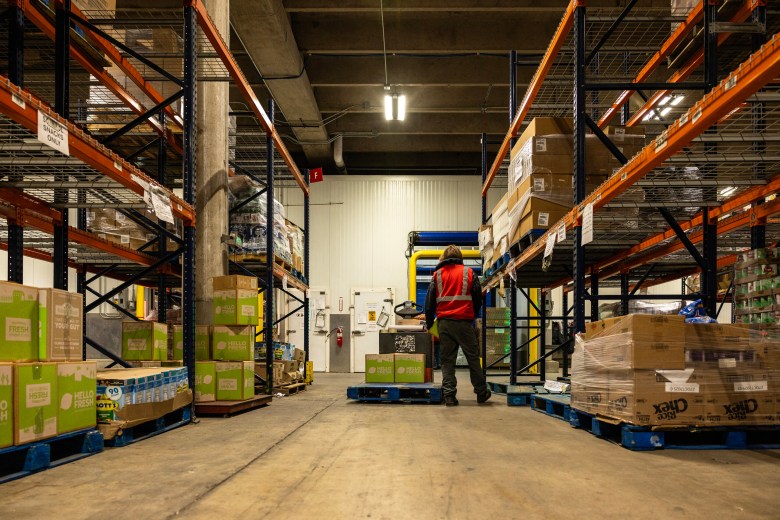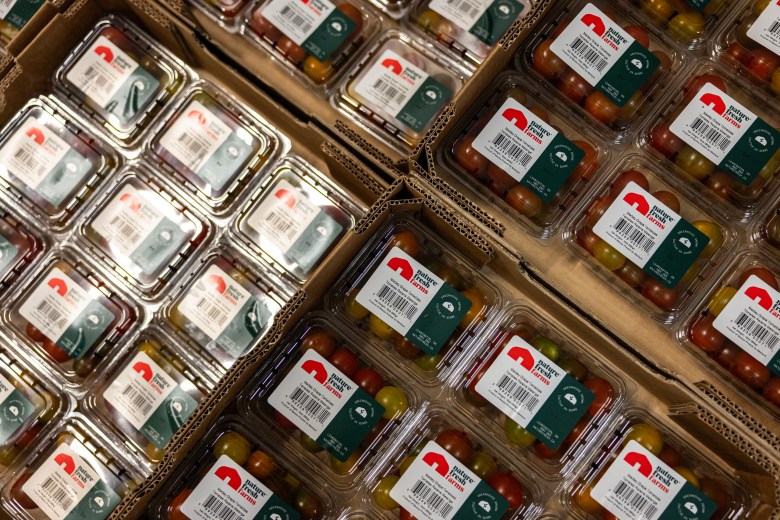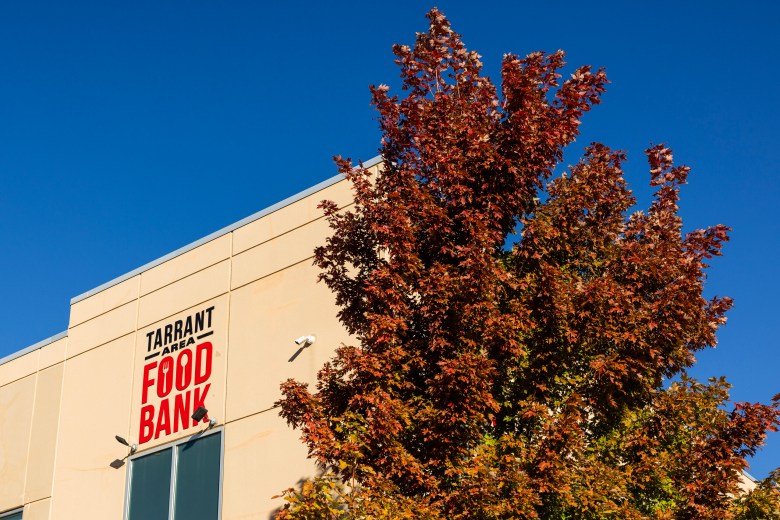Tarrant Area Food Bank’s distribution center, which is nearly 40% larger than a football field, has 20-foot-high shelves that are nearly always stocked with food.
On a normal day, the life cycle of food on-site — from being stocked on the shelves to distributed to one of the food bank’s 500 partners — is at most 48 hours, said Jared Williams, vice president of government and external relations.
Given the nation’s longest government shutdown in history and the food stamps program losing funding for the first time ever, that time has shrunk to 24 hours.
“It’s not that this is a race to do, but right now, it is a race to do to meet the needs of the people out there,” said Mike McDougan, one of the volunteers working on Tuesday.
While on-site, food is often prepared for partner organizations, whether that’s simply stacking the shelves or placing 40 pounds of cans in boxes, as volunteers were doing earlier this week. Demand for help has increased, putting the nonprofit on track to spend most of its $5 million set aside for food purchases this fiscal year by January, officials said.
Normally, Tarrant Area Food Bank distributes 1.25 million meals each week to its 13-county service network, said Stephen Raeside, the nonprofit’s chief development and external affairs officer.
 Shelves are emptier than usual at the Tarrant Area Food Bank in Fort Worth on Nov. 3, 2025. (Maria Crane | Fort Worth Report/CatchLight Local/Report for America)
Shelves are emptier than usual at the Tarrant Area Food Bank in Fort Worth on Nov. 3, 2025. (Maria Crane | Fort Worth Report/CatchLight Local/Report for America)
The food bank has begun dispensing double that amount with plans to continue at that pace for the next three months, Williams said.
That means the food bank must increase operating costs, volunteering efforts and the acquisition of food, officials said.
“With federal workers missing paychecks and SNAP participants not receiving their benefits, that adds an increased amount of demand on our partners,” Williams said. “So then they order more, and our inventory is pushed out faster.”
Like most food banks in the United States, Tarrant Area Food Bank has seen a significant increase in demand for services over the last five weeks since the shutdown began in October. That need was exacerbated after the federal SNAP program, which provides grocery purchasing benefits to 42 million people nationwide, lost funding on Nov. 1.
 Fresh produce is available at the Tarrant Area Food Bank on Nov. 3, 2025. (Maria Crane | Fort Worth Report/CatchLight Local/Report for America)
Fresh produce is available at the Tarrant Area Food Bank on Nov. 3, 2025. (Maria Crane | Fort Worth Report/CatchLight Local/Report for America)
Lingering effects
Not all the food distributed by the food bank is purchased. In fact, 95% of food passing through the nonprofit in fiscal year 2024 came from donations and government programs.
But given the lack of surplus available from the food industry in recent years, food banks nationwide have had to buy more of the food they give away.
Tarrant Area Food Bank CEO Julie Butner said the nonprofit set aside $5 million to purchase food for its 2026 fiscal year, which started in October.
With the food bank doubling distribution operations in reaction to SNAP cuts, Butner said most of the funds will be used by January.
Although this doesn’t necessarily mean the food bank will run out of food by the end of the fiscal year in September, choices will be limited by that point, Butner said.
“We’re kind of hedging a bet,” Butner said. “We can’t have starving people in our community, so we’re going to go ahead and spend the money, hoping that the federal government will reopen and that that 90-day period will get the wheels in motion again.”
“We can’t have starving people in our community.”
Julie Butner, CEO of Tarrant Area Food Bank.
The risk is calculated to meet an immediate need, officials said. At one of Tarrant Area Food Bank’s recent distribution events in Denton, for example, the nonprofit served over 1,000 families, well over the regular amount of 500, Raeside said.
The long-term needs of the community, however, can’t be serviced by the food bank alone. Butner previously told the Fort Worth Report that no foundation, millionaire or other government entity “can offset what the federal government does with our taxpayer dollars.”
 The Tarrant Area Food Bank serves 13 counties in North Texas on Nov. 3, 2025. (Maria Crane | Fort Worth Report/CatchLight Local/Report for America)
The Tarrant Area Food Bank serves 13 counties in North Texas on Nov. 3, 2025. (Maria Crane | Fort Worth Report/CatchLight Local/Report for America)
Doubling operations is a temporary solution until SNAP is brought back, officials from the nonprofit said.
“(It’s an) absolute necessity that we try to bridge that gap as much as possible by purchasing food,” Raeside said.
President Donald Trump announced earlier this week that SNAP funds would be partially reinstated, but that it would take weeks — or maybe even months — for the program to start running again.
Nov. 6, a federal judge ordered the reinstating of SNAP funds by Nov. 7. Federal government officials immediately appealed the ruling.
Increased volunteering efforts
Keeping up with the increased pace means more volunteers are needed.
In a given week, Tarrant Area Food Bank has three volunteer shifts from Tuesday to Friday and two on Saturday, with occasional shifts on Monday. Each team has 50-70 volunteers with multiple teams often working the same shift.
Since the shutdown, more volunteers have signed up, and several shifts are full through November, Williams said.
Some volunteers sort cans, checking for quality, dents and expiration dates, while others work in the kitchen creating and packaging soup.
“We do some other volunteer work too in the community, but this is a great place to volunteer because there’s something different every time,” said Lee Ann McDougan, who spends time at the distribution center with her husband, Mike.
The southwest Fort Worth couple are retired, and said the work keeps them active while allowing them to make a difference.
“We were especially interested in the food bank because we know people who have struggled with food insecurity,” Lee Ann said.
The nonprofit employs 125 people, but volunteers are crucial to Tarrant Area Food Bank’s entire operation, Williams said.
Volunteers contributed about 3,750 days of work in 2024.
 Maura Triplett and other volunteers fill containers with homemade soup at the Tarrant Area Food Bank in Fort Worth on Nov. 5, 2025. (Maria Crane | Fort Worth Report/CatchLight Local/Report for America)
Maura Triplett and other volunteers fill containers with homemade soup at the Tarrant Area Food Bank in Fort Worth on Nov. 5, 2025. (Maria Crane | Fort Worth Report/CatchLight Local/Report for America)
Preparing for an unknown
This year’s shutdown is not the first time food banks have faced an unknown.
Raeside said the current situation is akin to the pandemic, when food banks had to adapt to difficult situations such as not having volunteers overnight.
“Having been through COVID and scaling our operations to meet that need, this very much feels like a similar situation,” Raeside said.
What’s noticeably different from the pandemic was the government support, which was incredibly high in 2020. This year, the federal government has pulled back much of its support, even before the shutdown with the introduction of federal funding cuts.
If SNAP is not funded in some capacity by Dec. 1, about $2 million in purchasing power will be lost every day in the food bank’s 13-county service area, Butner said.
“It’s pretty unique. I don’t think our country has faced this before,” she said.
Tarrant Area Food Bank can temporarily tape over the cracks but not for long. The increased distribution and spending by the food bank will no longer be enough if funding is not allocated to SNAP soon.
“I don’t think we have a long runway,” Butner said, referencing her fear of what could happen if the full funding is not reinstated soon. “It’s a short period of time to get this thing back in place.”
Ismael M. Belkoura is the health reporter for the Fort Worth Report. Contact him at ismael.belkoura@fortworthreport.org.
At the Fort Worth Report, news decisions are made independently of our board members and financial supporters. Read more about our editorial independence policy here.
Related
Fort Worth Report is certified by the Journalism Trust Initiative for adhering to standards for ethical journalism.
Republish This Story
Republishing is free for noncommercial entities. Commercial entities are prohibited without a licensing agreement. Contact us for details.
